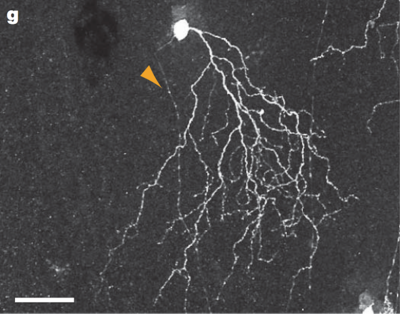Difference between revisions of "J-RGC"
(→Molecules) |
|||
| Line 1: | Line 1: | ||
| − | JAM-B cells are a molecularly defined subcategory of retinal ganglion cell in mice which respond specifically to upward motion. | + | JAM-B cells are a molecularly defined subcategory of retinal ganglion cell in mice which respond specifically to upward motion. [[Image:jamb010_side.png|400px]] |
Revision as of 12:35, 24 March 2012
JAM-B cells are a molecularly defined subcategory of retinal ganglion cell in mice which respond specifically to upward motion. 
Contents
Introduction
JAM-B cells are named after Junctional Adhesion Molecule B, the molecular marker first used to define them as a distinct subset of retinal ganglion cells. JAM-B share many traits in addition to the presence of this molecule. They are all OFF RGCs, with asymmetric dendritic arbors aligned in a dorsal-to-ventral direction across the retina (source: Kim et al.) Their deepest importance to the study and categorization of cells in the retina lies in that they were the first RGC to be classified using a molecular marker.
Anatomy
One notable feature of JAM-B cells is a marked asymmetry in their dendritic arbors. More than 90 percent of the dendritic arbor lies on one side of the soma. Asymmetry of the dendritic arbor is an unusual feature for a Retinal Ganglion Cell, as the dendrites of most Retinal Ganglion Cells are symmetrical.
The dendrites of JAM-B cells have been found to arborize in a narrow band between processes of dopaminergic and cholinergic amacrines (source kim et al.)
Physiology
It has been proposed that the asymmetry of a JAM-B cell's dendritic arbors is related to the direction selectivity.
The receptive field of J-RGCs is unusual in that the integrated strength of its ON surround exceeds that of the OFF centre. (Kim et al.) Studies imply that no sizable populations of OFF
RGCs exist with asymmetric dendrites pointing in directions other than dorsal-to-ventral (source: Kim et al.)
Molecules
Junctional adhesion molecule B is a protein that in humans is encoded by the JAM2 gene.[1][2][3] JAM2 has also been designated as CD322 (cluster of differentiation 322). Tight junctions represent one mode of cell-to-cell adhesion in epithelial or endothelial cell sheets, forming continuous seals around cells and serving as a physical barrier to prevent solutes and water from passing freely through the paracellular space. The protein encoded by this immunoglobulin superfamily gene member is localized in the tight junctions between high endothelial cells. It acts as an adhesive ligand for interacting with a variety of immune cell types and may play a role in lymphocyte homing to secondary lymphoid organs. (source: Wikipedia)